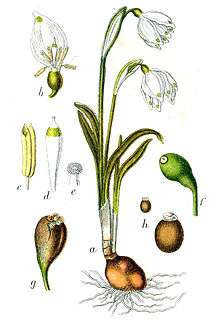Leucojum
| Snowflake | |
|---|---|
| | |
| Female Hairy-Footed Flower Bee (Anthophora plumipes) with flowers of Leucojum aestivum | |
| Scientific classification | |
| Kingdom: | Plantae |
| Clade: | Angiosperms |
| Clade: | Monocots |
| Order: | Asparagales |
| Family: | Amaryllidaceae |
| Subfamily: | Amaryllidoideae |
| Genus: | Leucojum L. |
| Synonyms[1] | |
| |
Leucojum is a small genus of bulbous plants belonging to the Amaryllis family, subfamily Amaryllidoideae native to Eurasia.[2][3][4]
As currently circumscribed the genus includes only two known species[1][5]
- Leucojum aestivum L. - summer snowflake or Loddon lily - Europe, Middle East, Caucasus; naturalized in Australia + North America
- Leucojum vernum L. - spring snowflake - southern + central Europe from Spain to Ukraine
Leucojum is a compound of Greek λευκος, leukos "white" and ἰόν, ion "violet". The spelling Leucoium is also used. Other common names include snowbell, dewdrop, and St. Agnes' flower.
Description

The snowflakes are native to central and southern Europe, from the Pyrenees to Romania and western Russia, but they have been introduced and have naturalized in many other areas, including the east coast of North America. They have narrow, strap-like, dark green leaves. The flowers are small and bell-shaped, white with a green (or occasionally yellow) spot at the end of each tepal. They have a slight fragrance.
Leucojum vernum (Spring snowflake) normally grows 15-20 cm tall (6-8 in), though it may reach up to 35 cm (14 in). It flowers one or two weeks later than the snowdrops, i.e., from mid-February to March, as soon as the snow melts in its wild habitat.
Two varieties are known: L. vernum var. vernum with green spots on its tepals, and L. vernum var. carpathicum, which originates from the eastern part of its natural range, a larger plant with yellowish spots on its tepals; 'vagneri' from Hungary is a robust variant of var. vernum, often with two flowers per stem.
Leucojum aestivum (Summer snowflake) has a wider natural range, taking in Europe (including the British Isles), southwest Asia and northern Iran, and growing in wetter habitats including damp woodland, riversides and swamps. Despite its common name it flowers from April to May, though later than the Spring Snowflake. It is a taller plant than Leucojum vernum, growing to around 60 cm (2 ft), but its flowers are smaller and are carried in an umbel of between three and seven. Its fleshy seed pods are inflated, allowing them to be dispersed by flood water. Leucojum aestivum subsp. pulchellum (Salisb.) Briq., native to the western Mediterranean Basin, is smaller: 20 cm (8 in), and flowers 2 weeks earlier, i.e., from mid-March.
 Summer Snowflake (Leucojum aestivum)
Summer Snowflake (Leucojum aestivum) Spring Snowflake (Leucojum vernum)
Spring Snowflake (Leucojum vernum) Flower of var. carpathicum
Flower of var. carpathicum Summer Snowflake (Leucojum aestivum)
Summer Snowflake (Leucojum aestivum)- Female hairy-footed flower bee (Anthophora plumipes) with Leucojum aestivum
Cultivars
Leucojum aestivum 'Gravetye Giant' is a selected cultivar with larger flowers. It is named after Gravetye Manor, an Elizabethan manor house in West Sussex, England, the home of the influential garden writer William Robinson from 1884 until his death in 1935. The house is now a hotel.
Leucojum vernum ‘Podpolozje’ is a robust cultivar which combines the properties of var. carpathicum with that of the variant ‘vagneri’, i.e., two flowers per stem and yellowish spots on its tepals.
Leucojum aestivum 'Gravetye Giant'[6] and L. vernum[7] have both gained the Royal Horticultural Society's Award of Garden Merit.
Acis
Nine former members of the genus, characterised by their narrow leaves, solid stems and unmarked flowers, have recently (July 2004) been reclassified as genus Acis. The Acis species prefer drier soils than Leucojum species. Four of them are autumn-flowering: Acis autumnalis, Acis ionica, Acis rosea and Acis valentina.
Cultural importance
Leucojum aestivum was named the county flower of Berkshire following a 2002 survey by the wild flower and plant conservation charity Plantlife.[8] It was once common in the Loddon Valley, hence its alternative name of the 'Loddon Lily'.
See also
References
- 1 2 Kew World Checklist of Selected Plant Families
- ↑ Stevens, P.F., Angiosperm Phylogeny Website: Asparagales: Amaryllidoideae
- ↑ Dolores Lledo, Aaron Davis, Manuel Crespo, Mark Chase and Michael Fay. "Phylogenetic analysis of Leucojum and Galanthus (Amaryllidaceae) based on plastid matK and nuclear ribosomal spacer (ITS) DNA sequences and morphology". Plant Systematics and Evolution (July 2004).
- ↑ Altervista Flora Italiana, genere Leucojum
- ↑ The Plant List search for Leucojum
- ↑ "RHS Plant Selector - Leucojum aestivum 'Gravetye Giant'". Retrieved 21 May 2013.
- ↑ "RHS Plant Selector - Leucojum vernum". Retrieved 21 May 2013.
- ↑ Plantlife website County flowers
External links
| Wikimedia Commons has media related to Leucojum. |
- Leucojum page from John Crellin's 'Floral Images' site with many pictures and links
- Pacific Bulb Society's Leucojum wiki page
- Pacific Bulb Society's Acis wiki page
- County flowers of the UK